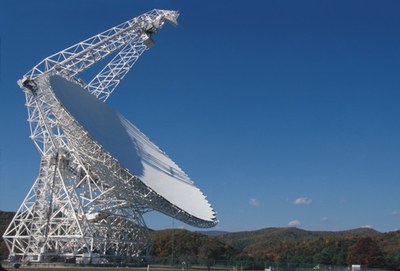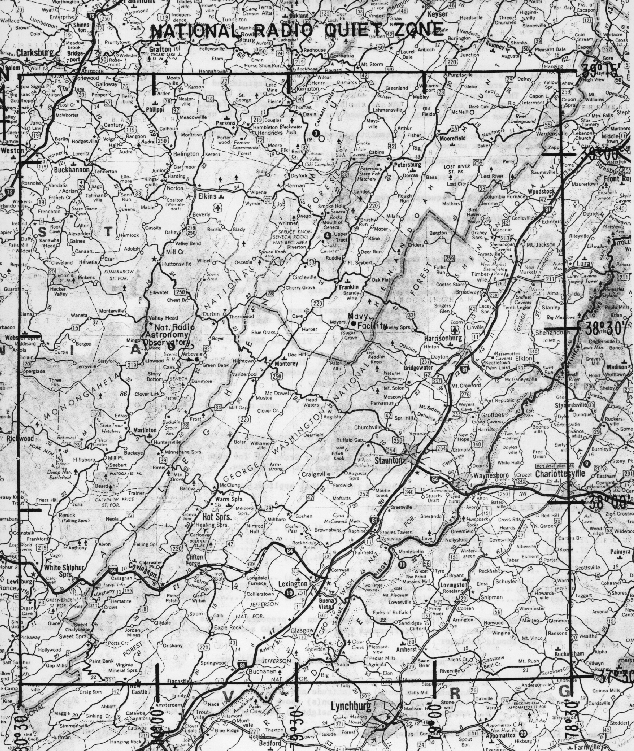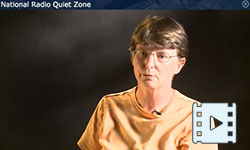National Radio Quiet Zone
This information is deprecated in favor of the new NRQZ documentation managed by Observatory Spectrum Management
Navigation
- Preliminary Evaluations
- Coordination Process
- Transmitter Evaluation
- Reference Point
- Power Density Thresholds
- Contact the NRQZ Administrator at 304-456-2107 or by email
Description
The National Radio Quiet Zone (NRQZ) was established by the Federal Communications Commission (FCC) in Docket No. 11745 (November 19, 1958) and by the Interdepartment Radio Advisory Committee (IRAC) in Document 3867/2 (March 26, 1958) to minimize possible harmful interference to the National Radio Astronomy Observatory (NRAO) in Green Bank, WV and the radio receiving facilities for the United States Navy in Sugar Grove, WV. The NRQZ is bounded by NAD-83 meridians of longitude at 78d 29m 59.0s W and 80d 29m 59.2s W and latitudes of 37d 30m 0.4s N and 39d 15m 0.4s N, and encloses a land area of approximately 13,000 square miles near the state border between Virginia and West Virginia.
The following black and white map is from the NTIA Manual of Regulations and Procedures for Federal Radio Frequency Management (Redbook).
Coordination Requirements: Federal and State of WV
NRQZ coordination is required for all new or modifed, permanent, fixed, licensed transmitters inside the NRQZ, as specified for federal transmitters by NTIA manual section 8.3.9 and for non-federal transmitters by the FCC in 47 CFR section 1.924.
The applicable radio services include but are not limited to: Public Mobile, Wireless Communications, Maritime, Aviation, Private Land Mobile, Personal Radio, Fixed Microwave, International Fixed Public, Satellite Communications, Radio Broadcast, Experimental Radio, Auxiliary and Special Broadcast, Cable Television Relay, Amateur Radio, Personal Communications Service, General Wireless Communications Service. Geographic Area Licensed Services are NOT exempt from NRQZ coordination. Applicants for some radio services are required to file their applications through independent frequency coordinators (e.g. APCO, AASHTO, PCIA, and IMSA). The coordinators assume the responsibility of notifying the Interference Office that an FCC application has been filed and hold the application until the Interference Office responds with its evaluation.
Coordination under the West Virginia State Code Chapter 37A “Radio Astronomy Zoning Act” (WVRAZ) may also apply.
Preliminary Evaluations
As a service to applicants who are planning to install transmitters within the NRQZ, our NRQZ Office can evaluate proposed transmitter installations long before an applicant decides upon a final transmitter location or equipment configuration. These preliminary evaluations can help the applicant determine the best location for a transmitter while keeping NRQZ interests in mind and can ultimately expedite the application process. The result produced by the preliminary evaluation is the maximum power that can be radiated by the proposed transmitter towards Green Bank. Requests for preliminary evaluations should be submitted to the NRQZ Office and should contain the following information:
- Name and address.
- Radio service.
- For each proposed transmitter:
- Frequency or frequencies
- Signal Bandwidth (if unknown, this information can be gathered from the technology type or the emission designator)
- Antenna location in latitude and longitude to nearest second.
- Antenna site ground elevation above mean sea level (AMSL).
- Antenna height above ground level (AGL).
Concurrence letters are NOT provided with this type of evaluation. Applicants, should they decide to proceed with the development of facilities associated with any preliminary study, will have to complete the coordination process by providing ALL appropriate final system configurations, applications and engineering. See section entitled “Methods of NRQZ Coordination” for further details.
Coordination Process
In order to minimize harmful interference to the operations of the NRAO in Green Bank and the Sugar Grove Research Station, all requests for new or modified, permanent, fixed, assigned or licensed transmitters within the NRQZ shall be coordinated by the applicant, prior to submission to the FCC or NTIA, with:
NRQZ Administration Office
National Radio Astronomy Observatory
155 Observatory Road
P. O. Box 2
Green Bank
WV 24944
Email: NRQZ Administrator
METHODS OF NRQZ COORDINATION
1. AutoPath Applicant Submission Template
2. nrqzApplicationMaker
3. Supplemental Information document (least preferred)
Please read and follow all instructions carefully.
If you have ANY questions or concerns, call the NRQZ office (304-456-2107) for assistance.
Additional information to assist you with your coordination request...
4. Common submission errors - A check list to insure proper processing of your initial submission
5. The Coordination Results (what you can expect once your analysis has been completed)
6. Coordination with Sugar Grove Research Station
7. Expedited processing
8. Tools:
- Color Map of the NRQZ
- Google Earth file of NRQZ
- Google Earth file of WVRAZ
- VIDEO: Dr. Karen O’Neil briefly explains the NRQZ and the WVRAZ.
COORDINATION PROCESS #1: AutoPath Applicant Submission Template
Download the AutoPath Applicant Submission Template excel worksheet. The document contains detailed instructions on the information required for processing. Please take special note to the format of the required fields. For example, output transmitter power is in Watts, AMSL/AGL is in meters, and coordinates are dd mm ss.ss where spaces are required between the values.
NOTE: This document can be used for coordination requests of MULTIPLE LOCATIONS, TRANSMITTERS, FREQUENCIES AND EMISSIONS!
Send your completed excel worksheet and all supporting documentation to the NRQZ Administrator for evaluation.
COORDINATION PROCESS #2: nrqzApplicationMaker
Download the nrqzApplicationMaker software to your desk. It have been made available to all applicants in the NRQZ for FREE courtesy of AKP Consulting Engineers. The nrqzApplicationMaker software has detailed instructions to guide you through the application process, resulting in a complete application file. Please include all required supporting documentation in your submission. Failure to do so may result in your RESUBMISSION of your coordination request.
Send your completed zipped file and all supporting documentation to the NRQZ Administrator for evaluation.
Need help with your nrqzApplicationMaker submission? Click here!
COORDINATION PROCESS #3: Supplemental Information Document
The applicant may use the NRQZ Application Technical Data - Supplemental Information document or provide the following information:
- Name and address of applicant.
- Radio service and Call Sign.
- FCC File or NTIA Assignment Number. The required supporting documents are the FCC application form or the GMF/Spectrum XXI unclassified assignment.
- For each proposed transmitter:
- Specific frequency, list of frequencies, or frequency band (low to high band pass)
- Signal Bandwidth (if unknown, this information can be gathered from the technology type or the emission designator)
- Antenna location in latitude and longitude to nearest tenth of a second. The required supporting documents are a FAA 1A survey, FAA 2C survey or Google Earth kml file. The NRAO nor the NRQZ office requires an applicant to aquire a site survey, however, if one has been done then this documentation should be provided with your coordination submission. If it is not available, the Google Earth kml file will be sufficient to process your analysis request.
- Antenna site ground elevation above mean sea level (AMSL).
- Antenna height above ground level (AGL).
- Antenna make, model number, and maximum antenna gain in dBd or dBi. The required supporting documents are (1) a manufacturers specification sheet detailing the antenna configuration and (2) the antenna gains in one degree increments for both the horizontal and vertical planes.
- Maximum output transmit power (dBW or W) per transmitter. If multiple transmitters are utilized, then indicate the number of transmitters that will be operating from each location.
Send your completed word document and all supporting documentation to the NRQZ Administrator for evaluation.
COORDINATION PROCESS #4: Common Submission Errors
1. Incomplete USPS mailing address of the applicant
2. Name, phone number and/or e-mail address of the technical contact (someone than reply to technical issues associated with your submission)
3. Coordinates and antenna height above ground level of ALL new or modified FX1 (6.1 meter) control points
4. Assuming that the assignment of a coordination case number (NRQZ ID x) indicates coordination. The assignment of a case number simply indicates that your case has been received and is in queue for processing. You will be contacted if there are possible errors in your submission or if additional information is required due to an NRAO or Sugar Grove Research Station objection.
COORDINATION PROCESS #5: The Coordination Results
If your proposed system meets the NRAO protection criteria, you will receive a coordination letter suitable to attach to an FCC application or NTIA assignment.
However, should the Effective Radiated Power (ERP) of your transmitter exceed what is allowable under the limit, the following additional information may be requested:
- A detailed system configuration that includes all system gains and losses.
- Antenna gain with horizontal and vertical patterns in one degree increments (in Planet or TIA-804-B Antenna File Format).
- Antenna azimuth (degrees true) and elevation.
- TOOLS FOR SUBMITTING COMPLIANCE ENGINEERING:
1. Site inspection worksheet #1, up to three transmitters per facility, no dual-beam or cross polarization antennas, or...
2. Site inspection worksheet #2, up to six transmitters per facility, dual beam and cross polarization antennas
COORDINATION PROCESS #6: Coordination With Sugar Grove Research Station
The Sugar Grove Research Station is a DOD Communications Facility located in Pendleton County, West Virginia.
It is possible that your evaluation requires coordination from the Sugar Grove Research Station facility. Should this be applicable to your request, the NRQZ office will contact them and coordinate on your behalf. As soon as they have commented, your case will be finalized. Please do not contact them directly!
TOOLS FOR SUBMITTING COMPLIANCE ENGINEERING:
COORDINATION PROCESS #7: Expedited Processing
Due to the case load currently experienced by both the NRAO and Sugar Grove Research Station, expedited processing is highly unlikely. If you are facing deadlines of some nature, please contact the NRQZ office for consideration. All expedited requests are handled on a case-by-case basis.
Transmitter Evaluation
The NRQZ Office reviews all applications to ensure that the computed power flux density at the reference point does not exceed frequency-dependent thresholds.
In some instances, the transmitter power requested by an applicant exceeds the level that is harmful to observations in Green Bank or Sugar Grove. When this occurs, applicants should discuss possible modifications to their transmitters (e.g. using a directional antenna, relocating the antenna to an area that provides additional terrain shielding, or selecting a different frequency where the power density limits are different) with the Interference Office. In our experience, a technical solution can almost always be found to provide the area coverage desired by the applicant while simultaneously minimizing the impact of the interference upon Green Bank or Sugar Grove. In the extremely rare case when differences between the applicant's desires and the Interference Office's evaluation cannot be resolved, both the applicant and the Interference Office should forward comments on the transmitter installation to the FCC or IRAC for a final resolution.
We emphasize that the Interference Office has no authority in the granting of an FCC license or a Federal Government frequency assignment. The Interference Office only has the privilege of submitting its comments on a particular transmitter installation to the FCC or IRAC.
Applicants who feel that their applications have been evaluated unfairly or inadequately can contact the office of the Green Bank Site Director for a review of their circumstances.
Reference Point
The reference point for calculations of transmitter power density is the prime focus of the Green Bank Telescope (GBT). The location of the GBT prime focus is:
Latitude: 38d 25m 59.2s N (NAD83)
Longitude: 79d 50m 23.4s W (NAD83)
Ground Elevation: 806 Meters or 2644 Feet AMSL (NAVD88)
Height: 139.6 Meters or 458 Feet AGL

Power Density Thresholds
Based on a 20 kHz measurement bandwidth, the calculated power density of the transmitter at the reference point should be less than:
- 1 x 10-8 W/m2 for frequencies below 54 MHz
- 1 x 10-12 W/m2 for frequencies from 54 MHz to 108 MHz
- 1 x 10-14 W/m2 for frequencies from 108 MHz to 470 MHz
- 1 x 10-17 W/m2 for frequencies from 470 MHz to 1000 MHz
- freq2 (in GHz) x 10-17 W/m2 for frequencies above 1000 MHz
except for frequencies that reside in the radio astronomy observing bands listed in the US Table of Frequency Allocations, in which case the power densities listed in Table 1 of Recommendation ITU-R RA.769 shall apply. For a comprehensive list, click here.
For more information about the NRQZ please contact: Paulette Woody
Phone: 304-456-2107
Fax: 304-456-2276
Email: NRQZ Administration




